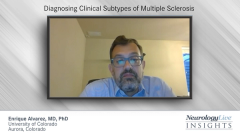
Monitoring Response and Sequencing Therapies in RRMS
Enrique Alvarez, MD, PhD reviews factors to consider when monitoring response to treatment, and Lawrence Steinman, MD comments on patient- and disease-related factors that may impact therapeutic sequencing.
Episodes in this series

Enrique Alvarez, MD, PhD: After you’ve decided to start a treatment, it becomes important to monitor and decide when you might need to change to a different disease therapy. Maybe they’re not tolerating it. Maybe they had some new disease activity with a relapse or new MRI lesions, and it’s time to switch. At the appointment, I tend to think about what monitoring is needed for the old drug and what testing might be needed for the new drug. I don’t tend to have any hard stops for what drug I will or will not go to from prior drug. My timing for treatments tends to rely on when the next treatment—for whatever drug they were previously on—would be due. For example, if I’m going from natalizumab to an anti-CD20 therapy, I would wait the 4 weeks until the next time they would expect to get their natalizumab treatment, then start their infusions with a B-cell therapy. If it’s for new disease activity, I might move that up. Otherwise, I tend to follow the schedules.
If I’m going from a CD20 therapy to something else, I usually wait 6 months if it’s from an infusible therapy if I’m looking at switching from Kesimpta. It’s a new medicine, so we haven’t done a ton of this yet, but I would think about starting the other therapy a month after their last treatment. That’s a nice guideline for that.
I don’t think there’s a standard around when to do imaging in these transitions. Even within our center, some providers like to do an MRI without contrast at 3 months to help set up a baseline, to say, “This is my baseline on drug, and any new lesions after that, I would switch therapy from that.” I like to do it at 6 months, and I tend to do MRIs with contrast. My rationale is that contrast will help me decide and change therapy again if I need to. If I see new lesions, I may not change therapy because I’m assuming that they’re old lesions and probably popped up in either old therapy or in the transition to the new therapy. But if I see a contrasted lesion at 6 months on the new therapy, it suggests that lesion is newer and maybe popped up in the last 1 to 3 months. I would like that therapy to be effective by that point. At that point, I would really start to consider switching therapy. That gives me a rationale for doing that MRI besides just using it as a baseline.
I don’t know that any strategies are right or wrong. The important point for this is making sure you get that MRI and you’re monitoring for MS [multiple sclerosis], while remembering that 90% to 95% of the disease activity is subclinical and normally detected at MRI. It becomes important to follow patients with MRIs on a routine basis.
The other question that comes up is for patients with progressive disease is, when do you do an MRI? For patients who are progressive, I like to get an MRI around that transition point if they’ve not had 1 especially for a while. We’ve seen a fair number of patients switch because they got labeled as having progressive disease, when in fact that progression was due to PML [progressive multifocal leukoencephalopathy]. Clinically, we sometimes should be able to tell the difference. Progression in PML is a little faster than progressive disease from MS, especially progressive phase without new attacks. Progression in MS from progressive phase should be about the same as you would expect progression to be in Parkinson disease, Alzheimer disease, or other neurodegenerative diseases, which take 6 months to a year before you notice a difference. Month to month, a patient should not be able to look at it from a progressive course and be able to say, “I could do that, and I can’t do it now.” If that’s the case, it becomes important to do an MRI to rule out that it’s not PML as part of the cause for that progression.
Lawrence Steinman, MD: The only reason I would switch is if it’s not working in terms of efficacy or if there’s a safety factor, like an allergic reaction. That would really make me not want to give it a second time. There are mild allergic reactions that we—the physician and the patient—soldier through and mitigate should they occur again. If I want to switch, I try to think of what interval of waiting I should do so that the 2 medications don’t interfere with each other or cause too much suppression of the immune system.
There aren’t strong guidelines, so you have to be sensible about the dynamic effect of a drug. For instance, how long an anti-CD20 will keep the B cells low before switching to another type of therapy, which will also reduce the availability of certain drugs to fight infections. It all depends on what I’m stopping and what I plan to proceed to in terms of sequencing. I do it based on the pharmacological properties of the medicine that the individual was on and the medicine that I intend to switch to, and a basket of issues, with safety factors being the most important. A lot has to do with what we call the pharmacodynamic effect of the drug. I don’t want 2 drugs to be given simultaneously that would knock and impair more than 1 major part of the immune system at a time.
With up-front therapy, I try to give the strongest drug that’s acceptable to the individual. As I explain to an individual that I’m face-to-face with, that generally is the drug that gives them the best shot at stopping the disease in its tracks. After that, I try to work with the patient to determine if there’s any pushback or reservations before I go to a different plan.
Transcript Edited for Clarity
Newsletter
Keep your finger on the pulse of neurology—subscribe to NeurologyLive for expert interviews, new data, and breakthrough treatment updates.


































